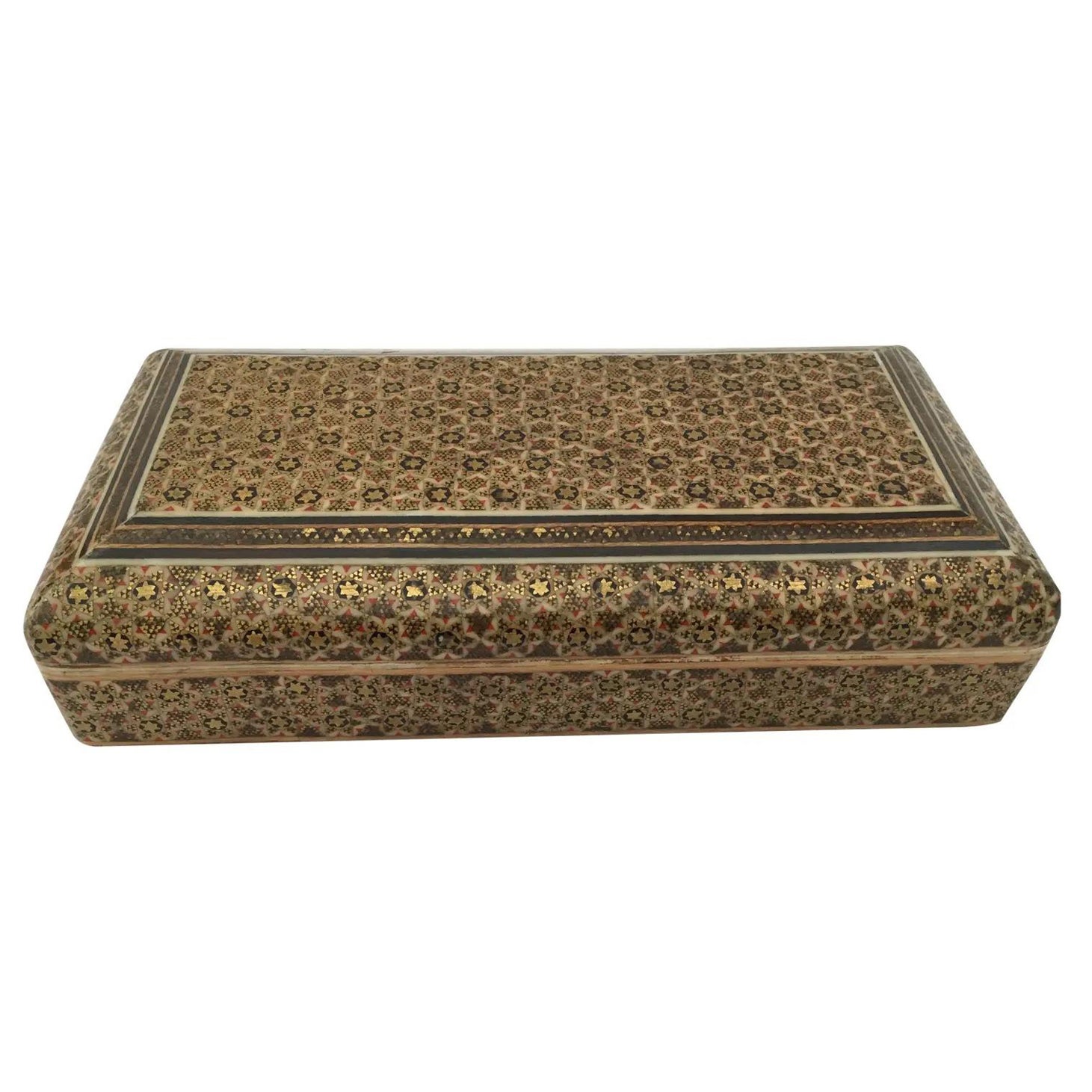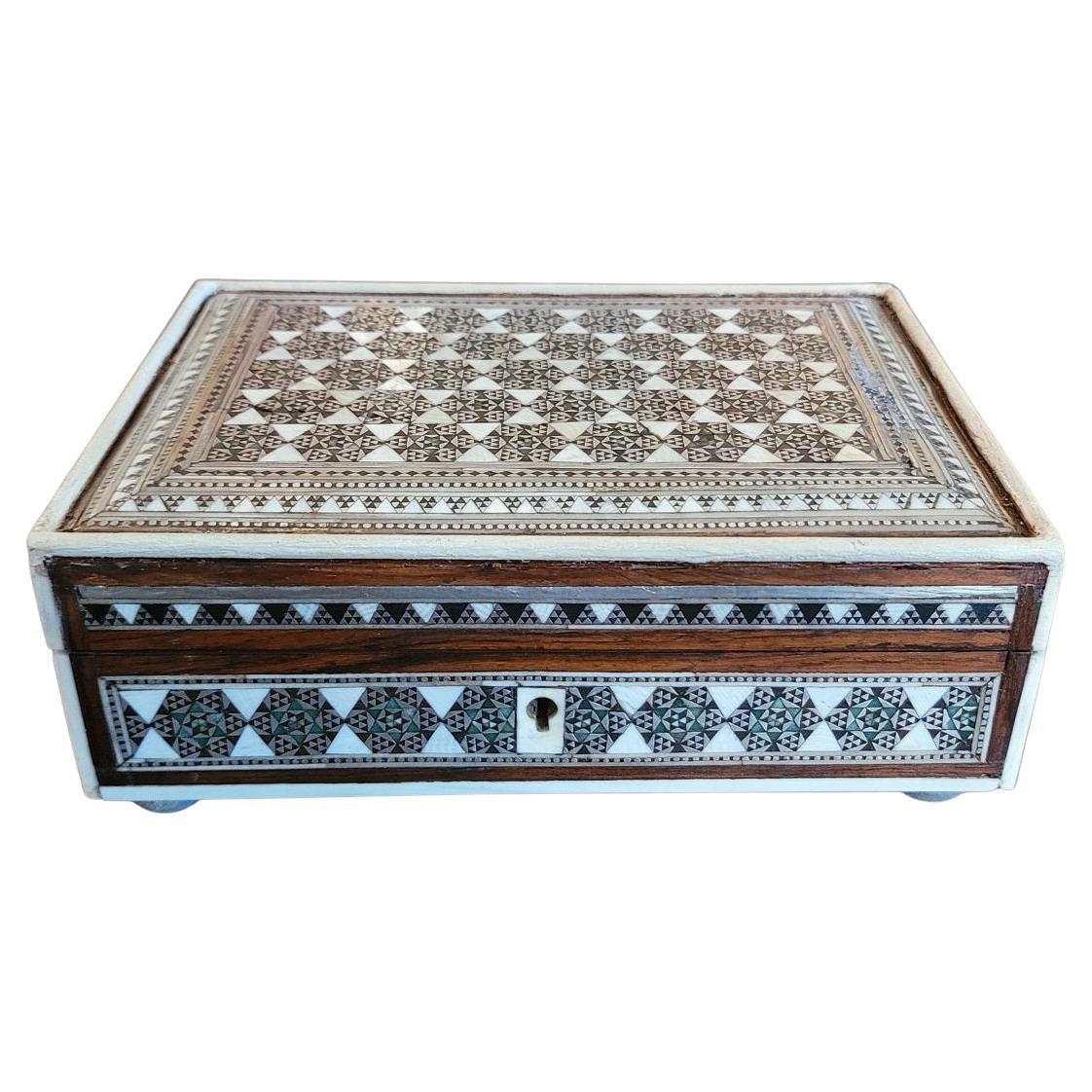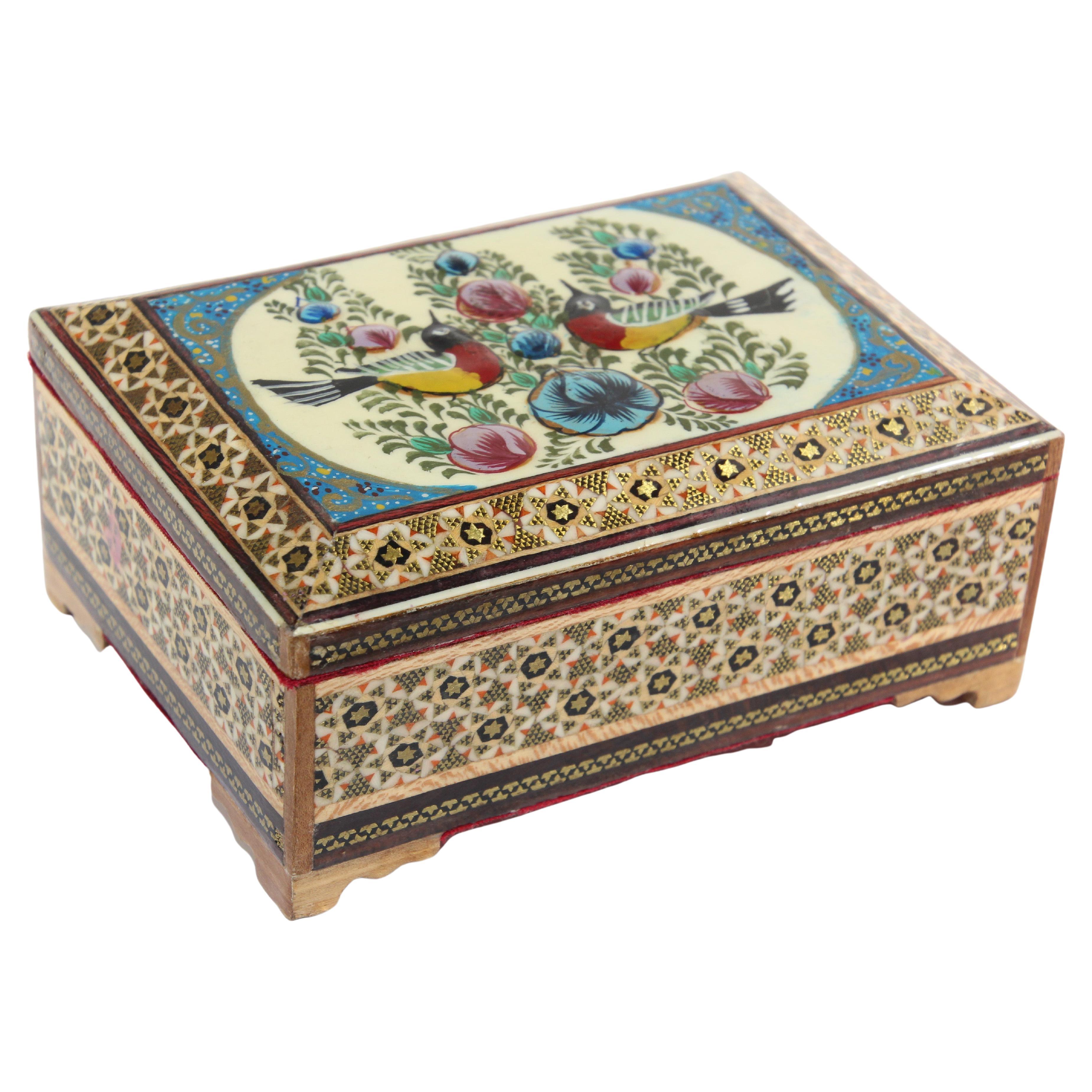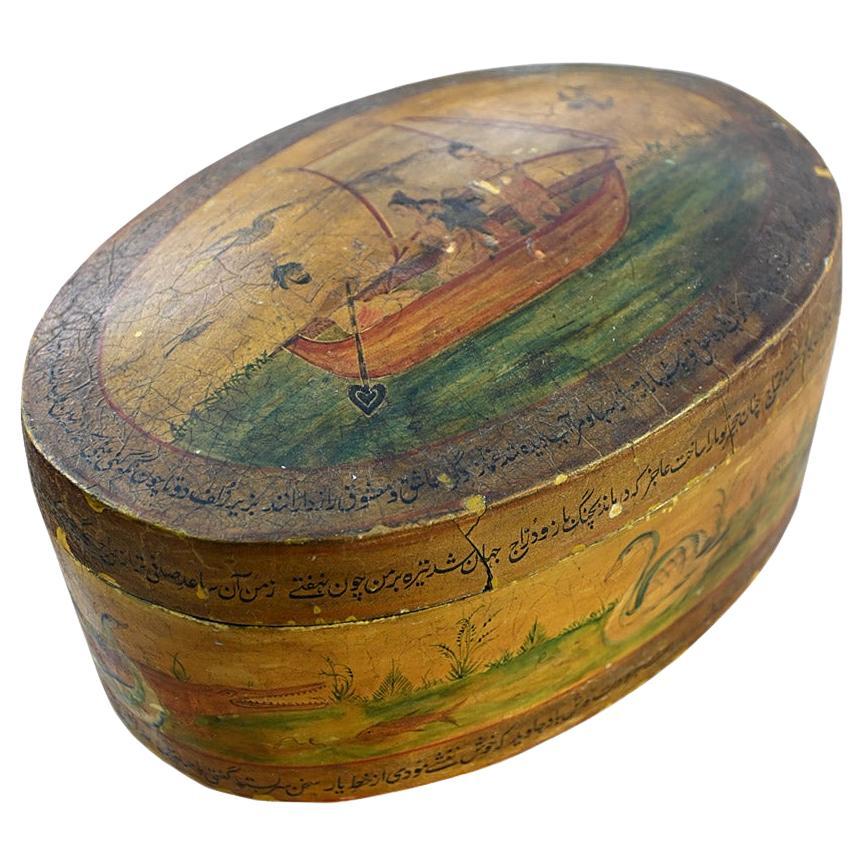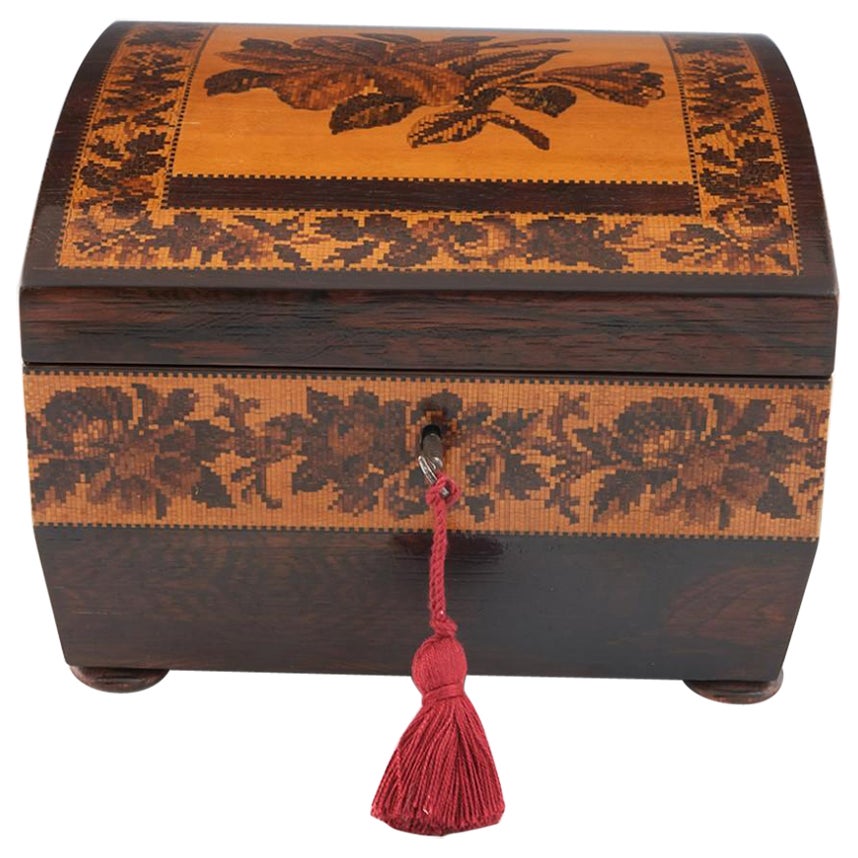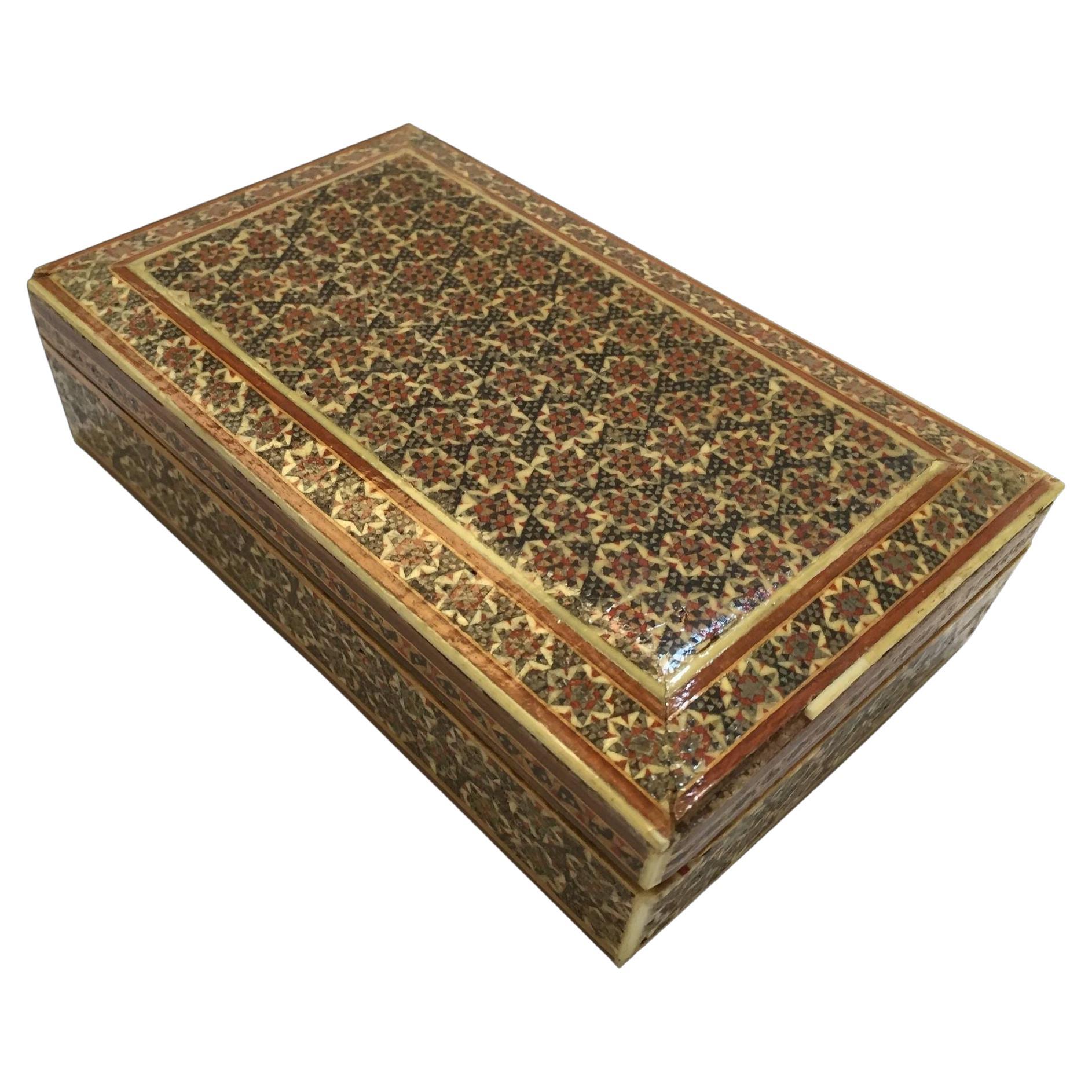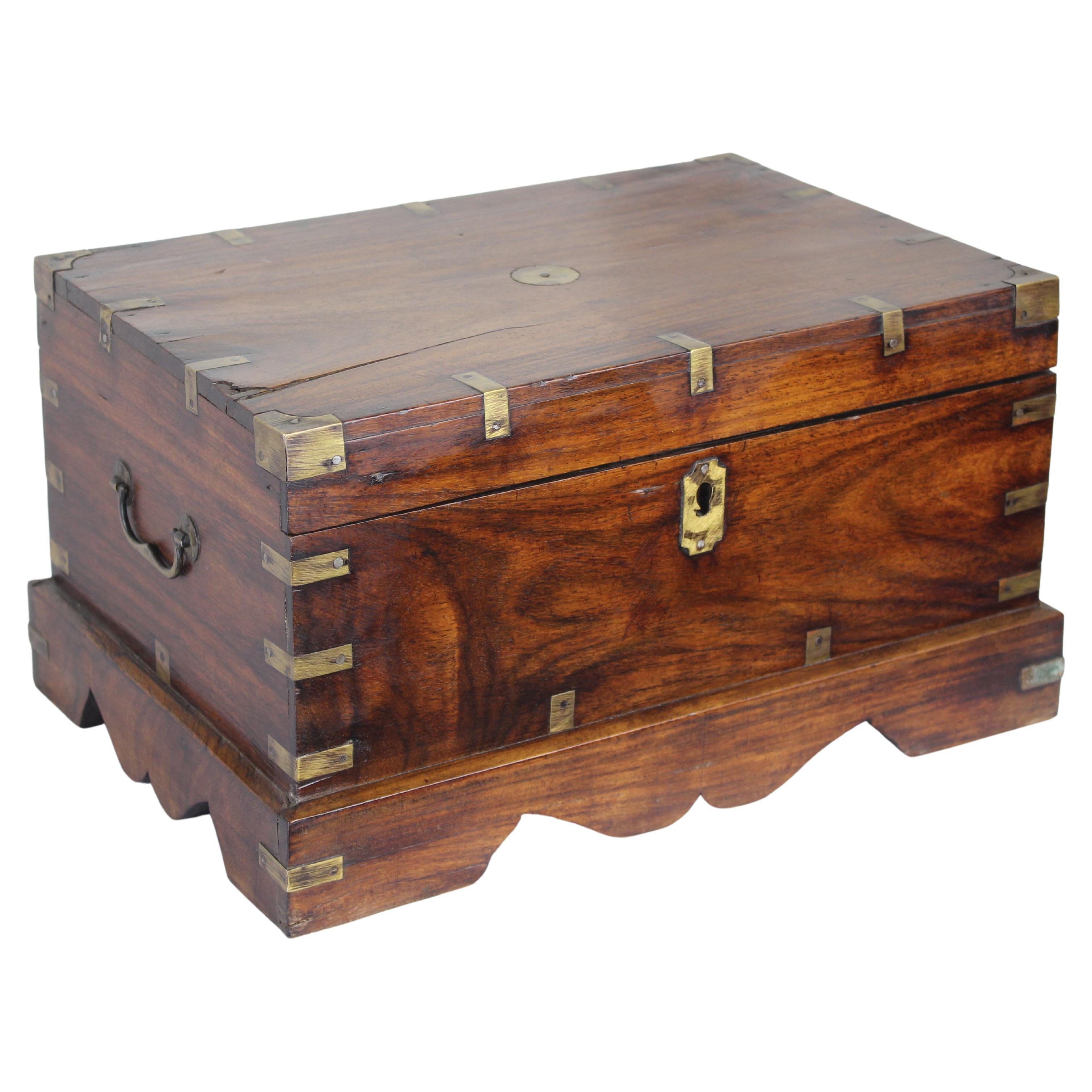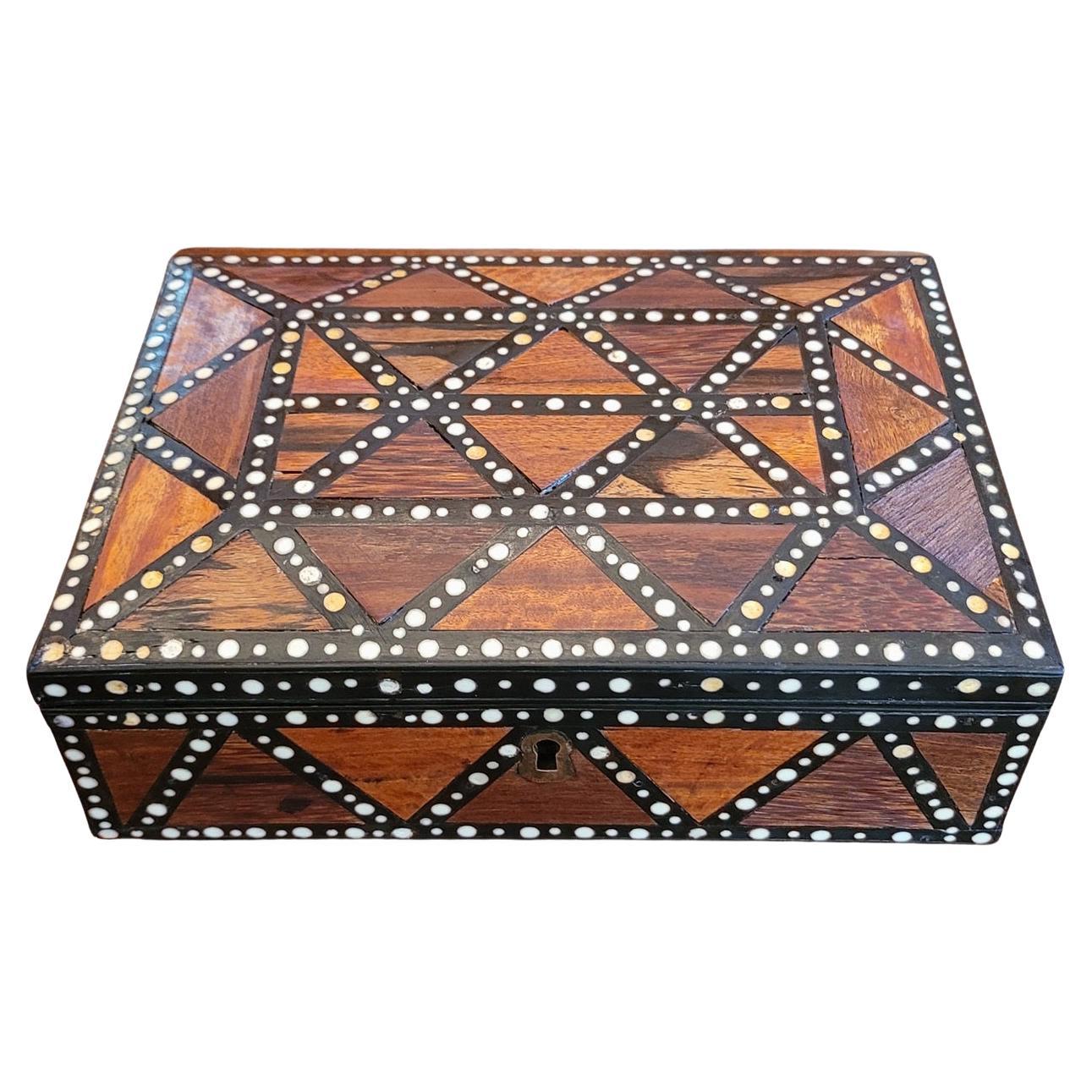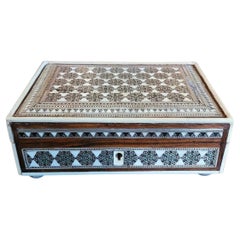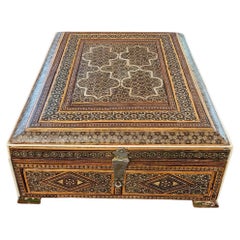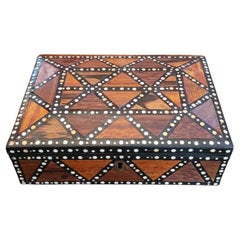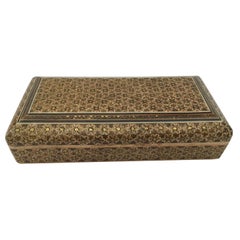
19 Century Indo Persian Mosaic Trinket Box with Amboyna
View Similar Items
Want more images or videos?
Request additional images or videos from the seller
1 of 7
19 Century Indo Persian Mosaic Trinket Box with Amboyna
About the Item
- Dimensions:Height: 1.75 in (4.45 cm)Width: 6 in (15.24 cm)Depth: 3 in (7.62 cm)
- Style:Anglo-Indian (Of the Period)
- Materials and Techniques:
- Place of Origin:
- Period:
- Date of Manufacture:1870
- Condition:Wear consistent with age and use. Very minor loss to some inlay mosaic on left, but not significant enough to devalue this rare piece.
- Seller Location:Dallas, TX
- Reference Number:1stDibs: LU3978112094743
About the Seller
4.9
Gold Seller
These expertly vetted sellers are highly rated and consistently exceed customer expectations.
Established in 2015
1stDibs seller since 2018
349 sales on 1stDibs
More From This SellerView All
- 19C Anglo Indian Bombay MOP Sadeli Mosaic Trinket BoxLocated in Dallas, TXPRESENTING a LOVELY 19C Anglo Indian Bombay MOP (Mother of Pearl) Sadeli Mosaic Trinket Box from circa 1875-85. Gorgeously detailed and hand-crafted ‘sadeli mosaic’ inlay, from the Bombay Area, with deep greens with silver, pewter, mother of pearl, bone and ebony in geometric patterns. The box case, is made of sandalwood but completely covered in MOP, bone, faux ivory, ebony and mosaic inlay. Edged with faux ivory and banded with a different pattern of sadeli mosaic. Some minor damage to the top (repair is obvious in pics) and ivorine replacements to some edging, but it still a BEAUTIFUL BOX and of real QUALITY! The mosaic work is FABULOUS! Box opens to reveal its original blue velvet lining. It sits on 4 (recently added) silvered button feet. SADELI MOSAIC: “Anglo Indian boxes were made in India for the English residents from the early part of the 18th century. They were brought back or sent back to England usually by the people who had commissioned them. From the beginning of the nineteenth century they were imported more commercially, although not in any significant numbers until the middle decades. They were very highly valued, especially the early ones, to the extent that the designs were copied on late 19th and early 20th century tins. The ancient art of Sadeli Mosaic is said to have been introduced from Shiraz in Persia via Sind to Bombay, a long time before the Anglo Indian boxes were made. It was a technique, which required a high degree of skill and patience. It was executed very lavishly, in that the frequent cuts wasted a great amount of the precious materials used. The workmanship was however more than commensurable to the value of the materials. Ivory, silver, pewter (or other metals), wood and horn were cut into faceted rods which were bound together to form geometric patterns. When the glue has set, the rods were sliced in transverse sections. This gave the maker a number of angled circular pieces in the original pattern. Several variations of patterns could be achieved by combining the materials in different ways. The ivory was sometimes dyed green to give an extra color. The mosaic pieces in a combination of patterns, often separated by ivory, ebony, horn or silver stringing were used to veneer sandalwood boxes. In the early boxes, which date from the turn of the 18th to the 19th century, there are large panels of mosaic covering tops and sides of boxes. It took incredible skill to cover such large areas without any shakes or wavering of the pattern. The corners and joins on these boxes are impeccably matched. The makers (reputed to be Persian) of Sadeli mosaic made in the first two decades of the 19th century displayed a total understanding of the qualities of the different materials they used. They combined substances, which can expand and contract according to atmospheric conditions with others, which are hard and unyielding. The result was a sharp definition of the lines and patterns, which made up the whole design. On the early boxes the designs look deceptively simple. The fact is, they emerged from a culture, which had mastered geometry and understood how to generate a pattern from a set number of points. The patterns are so harmoniously combined that their incredible complexity is not immediately apparent. The earliest Sadeli boxes...Category
Antique Late 19th Century Indian Anglo-Indian Jewelry Boxes
MaterialsSilver
- 18C Indo-Persian Campaign Vanity BoxLocated in Dallas, TXPRESENTING AN EXTREMELY RARE AND HIGHLY IMPORTANT Indo-Persian Campaign Vanity Box from circa 1780-1800. Box inlaid with exquisite mosaic inlay. In the Indo-Persian style of mosaic with Islamic styles. The mosaic consists of green semi precious stone, bone, brass and pewter in star shaped geometric designs. Box opens up to reveal a travel mirror...Category
Antique 18th Century Indian Anglo-Indian Decorative Boxes
MaterialsMulti-gemstone, Brass
- 19C Anglo Ceylonese Specimen Wood Trinket BoxLocated in Dallas, TXPRESENTING A BEAUTIFUL and RARE 19C Anglo Ceylonese Specimen Wood Trinket Box. Made in ‘Galle’, Ceylon (now Sri Lanka) circa 1860-80. Made for the ex...Category
Antique 19th Century Sri Lankan Anglo-Indian Jewelry Boxes
MaterialsBone, Hardwood, Ebony, Sandalwood
- 19th Century Samson Paris Porcelain Trinket BoxBy Samson & CieLocated in Dallas, TXPresenting a gorgeous French 19th century Samson Paris Porcelain Trinket Box probably by Edme Samson. Marked on the base with “Made in France” and unmistakably in the style and manner of Samson. The lid features hand painted floral bouquets on an ivory porcelain background with gold edging, surrounded by a sky blue lid with gold web or crackling effect.. The lid is hinged and the lid and base are edged in floral gilt metal mounts with Fleur De Lis clasp. It sits on 4 gilt metal or ormolu feet. The sides are likewise hand decorated. This wonderful antique hand painted box is just bursting with History. Inspired by Edme Samson of Samson & Co., Paris. we believe (based upon the markings and natural aging) that it was made between 1880– 1890 in France and was meant to resemble an antique of a much earlier period. It is very similar to Sevres pieces with it’s color, decoration and design. Samson specialized in reproducing antiques from the 1600 and 1700s. One of his most interesting works was his Heraldic or Armorial pieces. With this medium sized box, he was not only copying the larger porcelain caskets or coffin boxes...Category
Antique Late 19th Century French Louis XVI Jewelry Boxes
MaterialsOrmolu
- 19C Anglo Indian Highly Carved Padouk Wood with Sadeli Mosaic Inlay Sewing BoxLocated in Dallas, TXPRESENTING A LOVELY 19C Anglo Indian Highly Carved Padouk Wood with Sadeli Mosaic Inlay Sewing Box. Made in Bombay, India, circa 1880. The box is made of sandalwood with highly carved raised padouk wood panels on all sides, depicting temple scenes, animals and foliage. The box is in a sarcophagus form. It is edged in bone (and we can tell it is bone and not ivory, from the color and evidence of capillaries, which are not found in ivory), and banded with Bombay Sadeli mosaic and ebony veneer. The lid opens to reveal a removable tray with various open compartments and lidded compartments. 5 lidded compartments, 1 unlidded compartment and 8 holders for thimbles, etc The tray lifts to reveal a blue velvet (original) lined section, for storing jewelry etc, with sections for collars etc. The inside of the lid has a removable mirror (the mirror is missing on this one but can easily be replaced). Behind the mirror is the original green velvet lining. It has its original brass carry handles on the sides and sits on 4 silvered button feet (of recent origin). Some repairs to the exterior and condition issues (priced accordingly), but still a LOVELY COLLECTIBLE box! These boxes were made by superb Indian craftsmen, specifically for sale to the ruling British elite. These types of boxes, carved padouk and sandalwood, (whilst beautiful and superbly crafted) were of a lesser quality, than the more profusely and intricately mosaic inlay, tortoiseshell and ivory boxes, made for the British ‘Upper Classes’ in the areas of Bombay and Vizagapatam. These type of boxes were much more affordable back in 1880 (and indeed today) and would probably have been bought by mid-level diplomats, civil servants or visitors. Sewing boxes (in general), were in EVERY Victorian home in Britain in the 19th century and like other boxes etc were ‘status symbols’ of your place in society! The more ornate the box, the more ‘Upper Class’ you were! SADELI MOSAIC: “Anglo Indian boxes were made in India for the English residents from the early part of the 18th century. They were brought back or sent back to England usually by the people who had commissioned them. From the beginning of the nineteenth century they were imported more commercially, although not in any significant numbers until the middle decades. They were very highly valued, especially the early ones, to the extent that the designs were copied on late 19th and early 20th century tins. The ancient art of Sadeli Mosaic is said to have been introduced from Shiraz in Persia via Sind to Bombay, a long time before the Anglo Indian boxes were made. It was a technique, which required a high degree of skill and patience. It was executed very lavishly, in that the frequent cuts wasted a great amount of the precious materials used. The workmanship was however more than commensurable to the value of the materials. Ivory, silver, pewter (or other metals), wood and Horn were cut into faceted rods which were bound together to form geometric patterns. When the glue has set, the rods were sliced in transverse sections. This gave the maker a number of angled circular pieces in the original pattern. Several variations of patterns could be achieved by combining the materials in different ways. The ivory was sometimes dyed green to give an extra color. The mosaic pieces in a combination of patterns, often separated by ivory, ebony, Horn or silver stringing were used to veneer sandalwood boxes. In the early boxes, which date from the turn of the 18th to the 19th century, there are large panels of mosaic covering tops and sides of boxes. It took incredible skill to cover such large areas without any shakes or wavering of the pattern. The corners and joins on these boxes are impeccably matched. The makers (reputed to be Persian) of Sadeli mosaic made in the first two decades of the 19th century displayed a total understanding of the qualities of the different materials they used. They combined substances, which can expand and contract according to atmospheric conditions with others, which are hard and unyielding. The result was a sharp definition of the lines and patterns, which made up the whole design. On the early boxes the designs look deceptively simple. The fact is, they emerged from a culture, which had mastered geometry and understood how to generate a pattern from a set number of points. The patterns are so harmoniously combined that their incredible complexity is not immediately apparent. The earliest Sadeli boxes...Category
Antique Late 19th Century Indian Anglo-Indian Decorative Boxes
MaterialsBone, Padouk, Sandalwood
- 19C Anglo Indian Carved Padouk Wood and Sadeli Mosaic BoxLocated in Dallas, TXPRESENTING A LOVELY 19th century Anglo-Indian Carved Padouk Wood and Sadeli Mosaic Box, featuring a carving of a Hunt Scene. Made circa 1870 in Bombay, India during the Rule of th...Category
Antique Late 19th Century Indian Anglo-Indian Jewelry Boxes
MaterialsSilver, Pewter
You May Also Like
- Fine Antique Micro Mosaic Indo Persian Moorish Inlaid Trinket BoxLocated in North Hollywood, CAFine antique large handcrafted vintage marquetry Indo Persian wood inlay micro mosaic with miniature hand painted scene. Fine Antique handcrafted precious box micro mosaic inlaid in geometric design and with a miniature Islamic painting scene of men on horses. This beautiful collectible Moorish box in covered with fine Moorish micro mosaic marquetry and the top is decorated with a miniature painting of a 19th century scene of Royal princes wearing traditional Royal Maharajas clothes and playing polo on horse. The box is very finely inlaid inside and out. These Middle Eastern Persian inlay boxes were used to store pens. Museum quality piece like the ones in Doris Duke Islamic Art Museum. Finely handcrafted khatam wooden box with very delicate micro mosaic marquetry from the ancient Persian technique of inlaying from arrangements of so many delicate pieces of wood, mosaic marquetry. Dimensions. Height: 2.25 in. Width: 8.25 in. Depth: 4 in. Circa 1940s, handcrafted in Asia. Moorish mosaic Marquetry wear consistent with age and use, one tiny piece missing on the inside corner, not visible when the box is closed. Great Islamic Art collector museum quality piece on this miniature painting on boxes. Anglo Indian Moorish style micro mosaic inlaid jewelry box with lid. Intricate inlaid Anglo Indian box with geometric Moorish Sadeli design in an rectangular shape form with micro mosaic marquetry, very fine artwork. Museum collector piece like the one in Doris Duke Islamic Art Museum. The repeating geometric patterns of Sadeli Mosaic are what give it beauty and richness. This decorative technique is a type of micro mosaic featuring repeating geometric patterns. A highly skilled craft, it has had a long history in India and the Middle East with early examples dating back to the 16th century. In the 1800s, it became popular as a decoration on a variety of boxes, card cases, and chess boards imported from India. Since Bombay became a center of making them, they became known as Bombay boxes. The ancient art of Sadeli Mosaic is said to have been introduced from Shiraz in Persia via Sind to Bombay, a long time before Indian boxes appeared. The designs on early boxes look deceptively simple. The fact is they emerged from a culture which had mastered geometry and understood how to generate a pattern from a set number of points. The patterns are so harmoniously combined that their incredible complexity isn’t immediately apparent to the viewer. About Khatam Artwork: Khatam is a Persian version of marquetry, art forms made by decorating the surface of wooden articles with delicate pieces of wood, metal and other natural substances precisely-cut geometrical shapes. Moorish Jewelry, Islamic Mosaic, Middle Eastern Mosaic, Micro Mosaic Inlay, Egyptian Jewelry Box...Category
Early 20th Century Lebanese Islamic Decorative Boxes
MaterialsFruitwood
- Indo-Persian Khatam Micro Mosaic Jewelry BoxLocated in North Hollywood, CAHandcrafted Khatam wooden box with very delicate micro mosaic marquetry from the ancient Persian technique of inlaying from arrangements of so many delicate pieces of wood, precious wood, and delicate miniatures paintings. This beautiful Middle Eastern Persian style box is covered inside and out with fine Moorish micro mosaic marquetry. Indo Persian Moorish style micro mosaic inlaid jewelry box with lid. Intricate inlaid Asian Indian box with floral and geometric Islamic Moorish Sadeli design in a square shape form with inlay marquetry, very fine artwork, lined in red velvet. Museum collector piece like the one in Doris Duke Islamic Art Museum. The repeating geometric patterns of Sadeli Mosaic are what give it beauty and richness. This decorative technique is a type of micro mosaic featuring repeating geometric patterns. A highly skilled craft, it has had a long history in India and the Middle East with early examples dating back to the 16th century. In the 1800s, it became popular as a decoration on a variety of boxes, card cases, and chess boards imported from India. Since Bombay became a center of making them, they became known as Bombay boxes...Category
Mid-20th Century Asian Moorish Decorative Boxes
MaterialsWood
- Indo-Persian Brass Box with LidLocated in New York, NYIndo-Persian brass box with lid decorated with three prongs, bottom of box lined with velvet, incised with figural and floral patterns. .25" H x 8.5" W.Category
20th Century Decorative Boxes
MaterialsBrass
- Khatam Persian Micro Mosaic Marquetry Inlaid Jewelry Trinket Box 1950'sBy MamlukeLocated in North Hollywood, CAHandcrafted Middle Eastern wood inlay micro mosaic marquetry with miniature hand painted scene. Handcrafted khatam hexagonal shape wooden box with ...Category
20th Century Lebanese Moorish Decorative Boxes
MaterialsWood
- Mosaic Middle Eastern Moorish Trinket BoxBy MamlukeLocated in North Hollywood, CAHandcrafted marquetry Middle Eastern Moorish wood inlay micro mosaic with miniature hand painted scene of birds. Handcrafted khatam wooden box ...Category
20th Century Lebanese Moorish Decorative Boxes
MaterialsWood
- 19th Century Persian Papier Mache Hand Painted Trinket BoxLocated in London, GB19th Century Persian Papier Mache Hand Painted Trinket Box Covered in hand painted detail and illustrations, this 19th Century Persian trinket...Category
Antique 1880s Indian Early Victorian Decorative Boxes
MaterialsPaper

